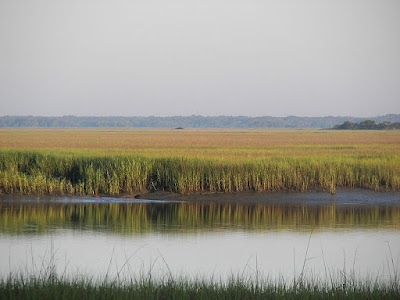 |
| View of Lettuce Lake from Observation Tower, Photo by Bruce G. Smith |
We enter the boardwalk behind the Audubon Center. The
path splits, and we take the left fork that eventually leads us to the
observation tower. At this point the Hillsborough River widens to form a slow
moving expanse of water known as Lettuce Lake.
In 1982 Hillsborough County created Lettuce Lake
Park. It is an urban wetland nestled close to the University of South Florida
campus. It forms part of the flood plain for the Hillsborough River, and
provides an excellent habitat for wildlife.
It is a great place for bird watching and observing
alligators. On this day we saw several alligators and turtles. We also observed
ibis, egrets, herons and many other birds. During the migratory season the
boardwalk provides an astounding array of waterfowl. We often see snakes hiding in the foliage.
 |
| Alligator Lettuce Lake, Photo by Bruce G. Smith |
From the top of the observation deck, most of the
park’s 240 acres are visible. In front of the deck is the largest portion of
open water. The canoe and kayak launch is not far from here, and it is
entertaining to watch novices honing their skills.
 |
| Banded Water Snake along Boardwalk, Photo by Bruce G. Smith |
We’ve been visiting the park for the last ten
years. Initially, it had very few visitors, and its pristine beauty in the
middle of Tampa amazed me. These days it gets many visitors, and trash has
become a problem. Unfortunately plastic water bottles float around the
alligators. Please remember to recycle your water bottles or better yet use
refillable containers.
We climb down from the tower, and walk back towards
the Audubon Center. The boardwalk covers about 3500 feet. Except in the driest
years the boardwalk is over water with open water on one side and cypress trees
on the other. One end terminates as a dock on the Hillsborough River, and the
other end provides a canoe and kayak launch.
 |
| Wolf Spider on Boardwalk, Photo by Bruce G. Smith |
On this excursion it is not too crowded, and we
walk the length of it several times taking pictures and chatting with other
people. The park has become a favorite location for photographers to practice
their skills, but today most of the visitors are locals enjoying a break from
the summer rains.
A large family group is a head of us, and we choose
to skip the dock. Instead we take a spur that leads to the parking lot and
playground. Usually connecting spurs don’t provide much in the way of wildlife,
but at Lettuce Lake this is not true.
 |
| Bull Frog at Corner of Spur and Main Trail, Photo by Bruce G. Smith |
We see as much wildlife along the spur as we see
along the main boardwalk. Birds, baby alligators, snakes and spiders abound
along the walkway. Once I encountered otters swimming under the spur’s boardwalk.
That was a pleasant surprise.
Lettuce Lake is a great place to spend a couple of
hours outside enjoying wildlife and nature. On some weekends it gets crowded
especially if all the picnic pavilions are rented and in use.
This trip occurred on a Saturday afternoon in late
summer. We received lots of rain this season, and the water levels were high
with some parts of the park flooded. It was not crowded, and very relaxing. It’s
a great place for visitors with a busy schedule to get a taste of Florida
wetlands and wildlife.

